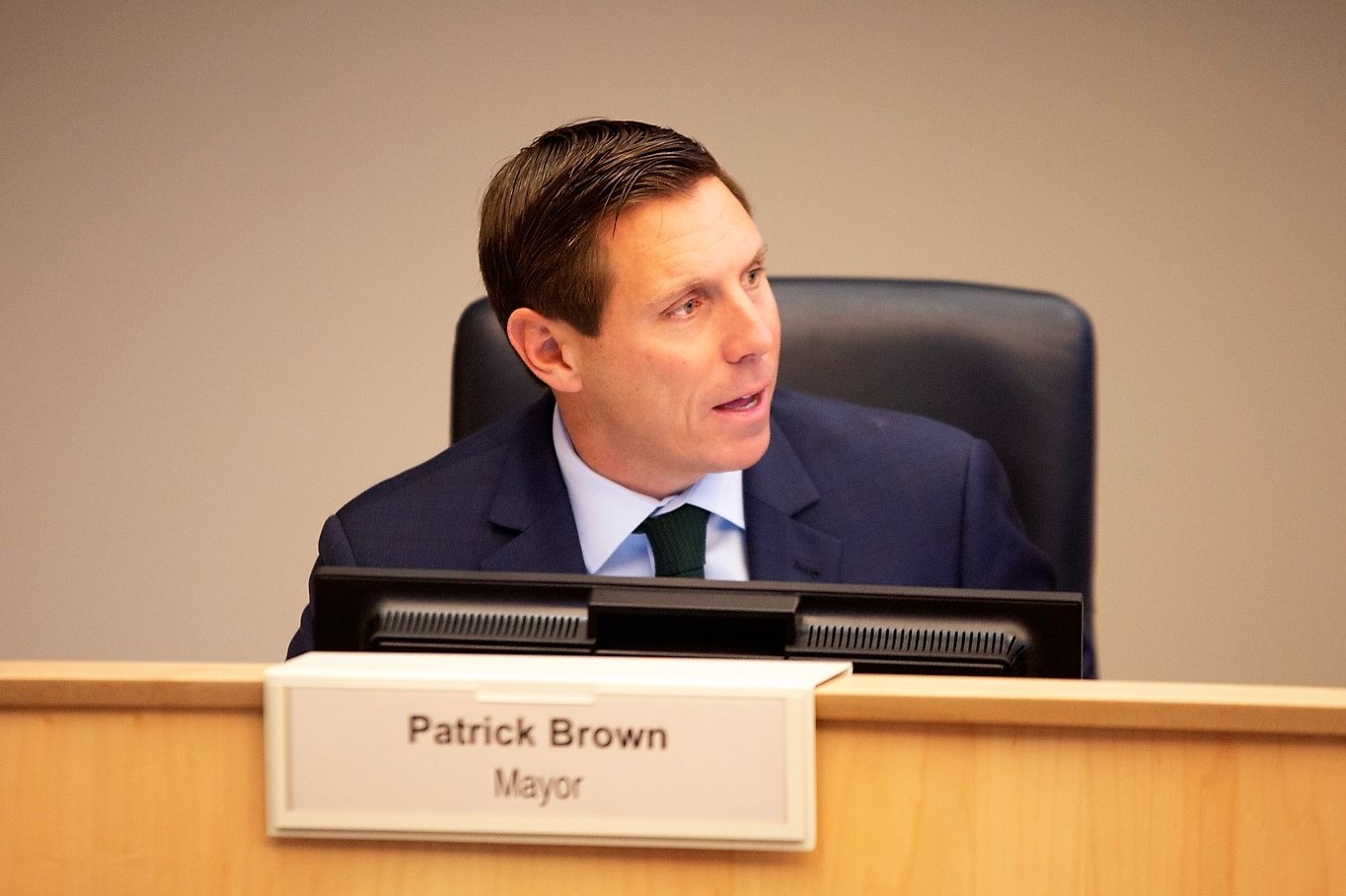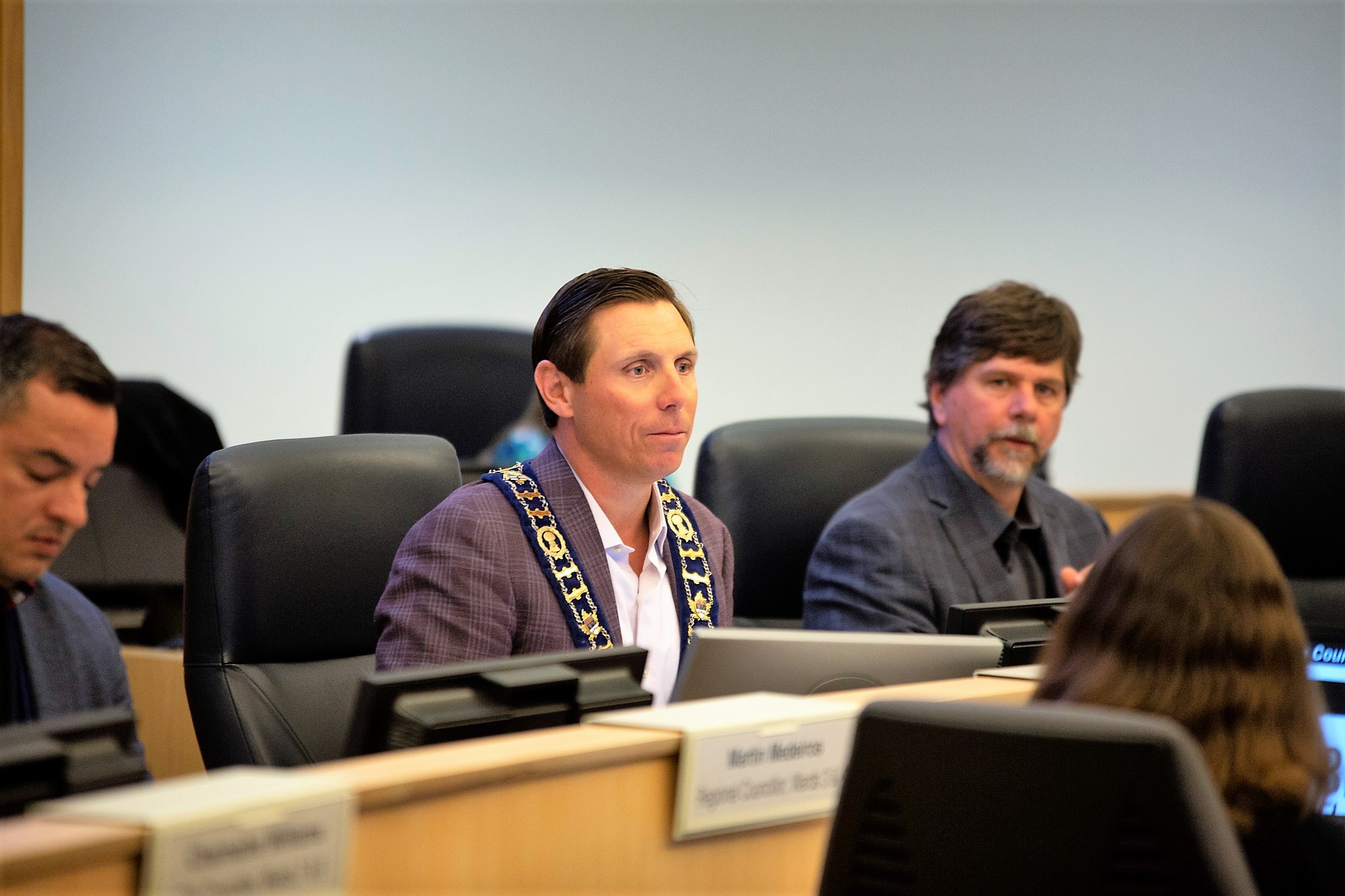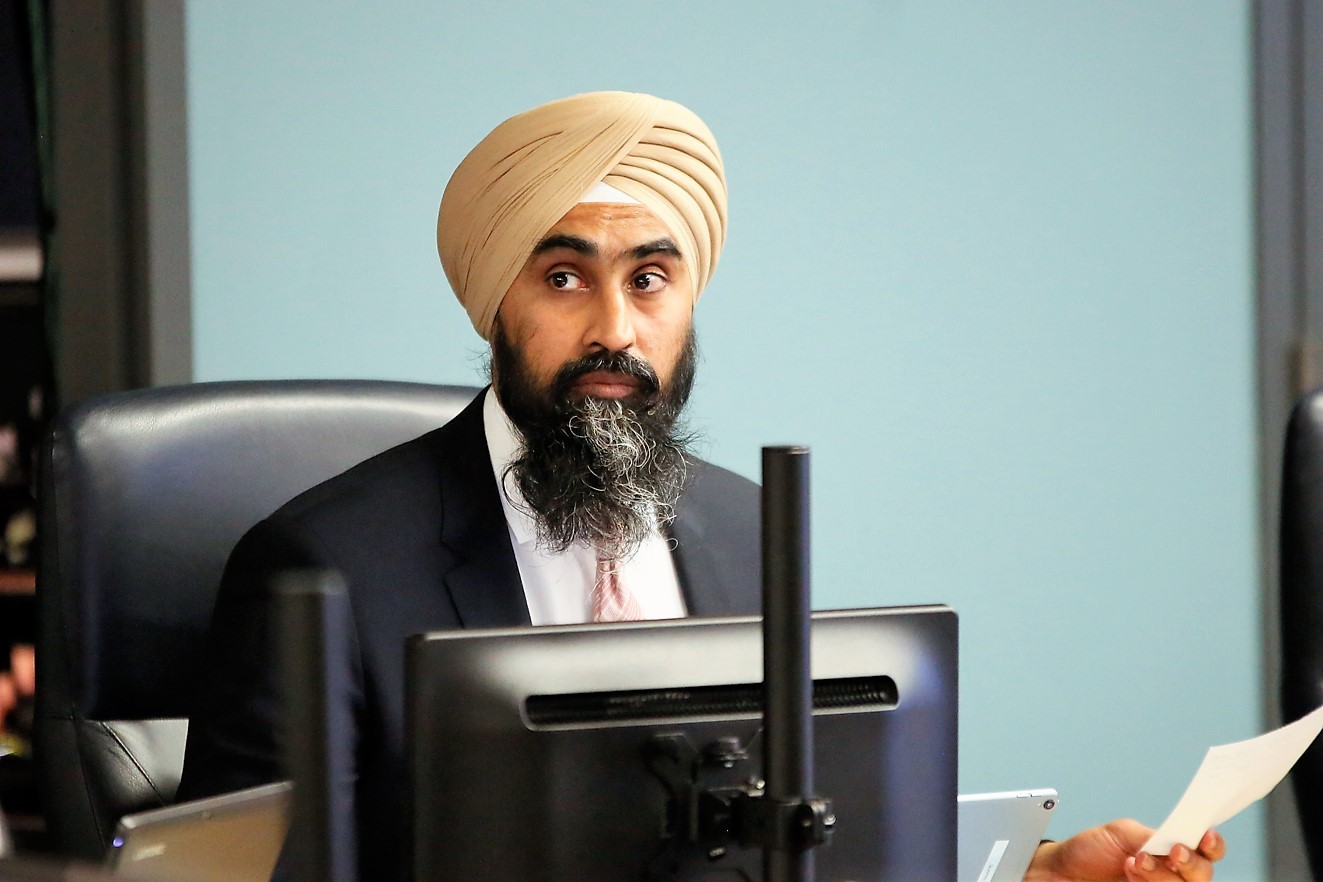
Brampton City Council votes in support of keeping Peel Region intact
Just hours before the official deadline of 11:59 p.m., Brampton city council, in a special meeting Tuesday night, voted to endorse the maintaining of a two-tier local governance system where the Region of Peel will remain as is. The stance had to be submitted to the province as feedback yesterday, even though the ultimate decision belongs to Premier Doug Ford’s PC government, which can disregard the city’s desire for its own future.
Mayor Patrick Brown, and the rest of council, spoke about a need to protect the taxpayer, claiming that the other two options, dissolving or amalgamating, would be far more expensive. “Based on the financial analysis, it protects taxpayers the most. If you look at the dissolution and or the amalgamation, it’s a big cost for taxpayers,” Brown said in a media scrum after the meeting.

Brampton Mayor Patrick Brown at Tuesday's special meeting
About a third of the public seating area in the council chamber was filled for the special evening meeting.
The analysis Brown referred to was done by consulting firm Deloitte, and quickly became controversial when it was learned that Peel Region senior staff and its chair Nando Iannicca commissioned the work without consulting regional council. Its findings, which supported the status quo, the desire of those who hired Deloitte, were torn apart by Mississauga councillors as being deeply flawed. Mississauga wants a divorce from the region to become its own independent city.
Regional Council then voted for a new analysis to be conducted by the firm Ernst & Young, using proper methods and in consultation with all three of Peel’s municipal partners, but that was only 12 days before the province’s deadline Tuesday to receive feedback ahead of its decision on the future of regional government across Ontario.
Brown told The Pointer Tuesday that the E&Y report would have to be looked at today, Wednesday, as it was not finalized and approved by the region until shortly before the midnight deadline, when it was to be sent directly to Queen’s Park.
It’s possible that the E&Y findings, which will represent Peel’s official position on what should be done by the province, could support dissolution or amalgamation, and not the status quo. The report could be made public today and will likely be assessed by regional councillors at this Thursday’s regional council meeting.
Brampton Council, based on months of consultations, also believes that the resolution it passed Tuesday evening, to keep Peel intact, is the will of residents, as surveys showed that Bramptonians favour the status quo.
“We’ve did our due diligence,” Councillor Gurpreet Dhillon said during Tuesday’s special meeting. “We did the responsible thing by collecting all the data. We did all the analysis and we spoke to our residents beforehand before making this decision and I think the numbers are clear. Amalgamation or dissolution will cost the taxpayers up to $1.1 billion.”

Brampton Councillor Gurpreet Dhillon
Efforts have been underway by the city to get resident input since early April when they launched a website that included important dates like Brampton’s own May 4 town-hall — which only a handful of people showed up for — and a consultation conducted by Ken Seiling and Michael Fenn, the province’s advisers for the governance review, at the regional council chambers recently, where no Bramptonians provided input.
The results of a region-wide Mainstreet Research poll, which conducted their telephone survey between Apr. 26 and May 1, demonstrates that Mississauga residents stand alone in their wishes for the region. Bramptonians and Caledonians overwhelmingly support keeping the region as it is, with 66 percent of Brampton residents wanting status quo and 64 percent of those polled in Caledon wanting the same.
The split in Mississauga appears to be more even. Just under half, about 48 percent, of Mississauga respondents want to “de-amalgamate” the region to give the city its independence and 34 percent want things to remain unchanged.
The study asked 2,018 people above the age of 18 what direction they would like the province’s regional review to take. A second poll of 1,500 Bramptonians also provided feedback on other related questions:
-
60.1 percent of respondents said the size of government was appropriate
-
25.6 percent thought that government was too large
-
14.2 percent believed that government was too small
On the question of amalgamation, the numbers appeared more split. A large number of Brampton respondents, 47 percent, don’t support amalgamation, however, supporters of merging the municipalities into one super-city are not far behind with 39.2 percent favouring that outcome. When asked if they knew the regional review was happening, residents were almost evenly split at 50.1 percent saying they were not aware and 49.9 percent saying they were.
The majority of Bramptonians seem to also want the region to provide most of the services, the exception being policing. Some 52 percent of respondents want Peel Regional Police to be a municipal service, with the city operating its own force.
“We took a very, very large sample. The sample, I would say, is even large enough to be a solid representative of Brampton, Mississauga — Caledon is different because it is a lot smaller. I think if we were to repeat this with some other method … the findings wouldn’t be any different,” Joseph Angolano, vice president of Mainstreet Research, said in the chambers.
The results of the Mainstreet poll do appear to fall in line with other studies conducted by the city. A tele-town hall done at the end of April, in which 5,000 people participated, showed that 66 percent of Bramptonians who responded during the informal survey wanted the status quo. A similar online poll found that, out of 629 respondents, 59 percent wanted Peel to remain as is.
The results of the poll are reflected in the feedback by some of the residents and business-people in the city. Rick Evans of CCV insurance told The Pointer that the status quo should be maintained because dissolution would, according to him, produce duplication of service.

Brampton resident and business owner Rick Evans
“I think there are sufficient efficiencies in having regional services provided on a regional basis. I don’t see a duplication of Peel police. Breaking it into components, we have duplications of head offices, of all of the hierarchy that’s required, I just don’t see that as worthwhile,” Evans said over the phone before the meeting.
Jotvinder Sodhi, of consumer protection organization HOWAcrp, does not support amalgamation or dissolution because of the added cost of the change that he believes would be a result and because, according to him, Brampton is financially not equipped to handle the undertaking.
“I’m not supporting the additional load on the property owners. The business and property owners in Brampton they’re already paying high, and we don’t have the business opportunities in Brampton, our infrastructure is in a very bad shape,” Sodhi told The Pointer over the phone Tuesday ahead of the meeting.
The ruling provincial PCs announced in January that Premier Doug Ford, through Minister of Municipal Affairs Steve Clark and his advisors, Seiling and Fenn, will be moving forward with the review this summer. They have stated that their work will not be public and any decision-making, including consideration of the positions sent by the impacted municipalities, will be done behind closed doors.
When asked why such a late time and date was chosen for the special Brampton Council meeting to pass a resolution establishing the city’s official position on its future governance structure, spokesperson Natalie Stogdill said, “Since April, the City actively engaged residents and other stakeholders on the three options for regional governance, to split, merge or stay. It is only fair to our taxpayers that the City considers and examines all available input and financial analysis studies in order to make an informed decision that is in the best interest of Brampton taxpayers.”
Status quo would mean that the Region of Peel will remain as it is now, with Brampton, Mississauga and Caledon married together in a two-tier system. But the other two scenarios, dissolution and amalgamation, could have sizeable financial consequences.
Auditor Deloitte, whose financial analysis was the subject of a falling out between Peel’s municipalities, said in its report, commissioned quietly by the region without regional council approval, that the transition toward amalgamation would require roughly $676 million in levies whereas dissolution would need $1 billion in levies.
Mississauga councillors and Mayor Bonnie Crombie, who have all been calling on Mississauga to separate from the region, questioned the integrity of the report saying that it was done without proper consultation with the three municipalities and that the findings used sweeping assumptions while other important factors were ignored by Deloitte.
Regional council opted to commission another $660,000 report, this time by Ernst & Young, with a much larger scope and involving all three municipalities directly — The Deloitte report did not contain data from the individual municipalities, the E&Y work was to be done with the CAOs and senior financial staff of Peel, Brampton, Caledon and Mississauga.
In the absence of the new feedback by E&Y, which was not ready until right before Tuesday’s midnight deadline, Brown said he was satisfied with the controversial Deloitte report as the official stance of the region because it “is the only financial analysis done by the region and it will be our submission as fact.”
That is not the position of Mississauga Council and the Peel Region Council, which Brown sits on. They will be using the $660,000 E&Y report to support their recommendations to the province. The contentious back and forth between Brampton and Mississauga has created a scenario with two competing reports, both paid for by Peel taxpayers, that could contradict each other.
“Region of Peel Council unanimously commissioned Ernst & Young to deliver a financial analysis report due today May 21, 2019,” Stogdill told The Pointer Tuesday. “Out of respect for the work that the Cities of Brampton, Mississauga and Town of Caledon have put in for this independent study and to ensure we are doing our due diligence, the Special Council Meeting of Brampton City Council is scheduled for late this evening. If the financial analysis from Ernst & Young is received in time, the City will also consider the information from (its) report.”
Email: [email protected]
Twitter: @mansoortanweer
Submit a correction about this story


